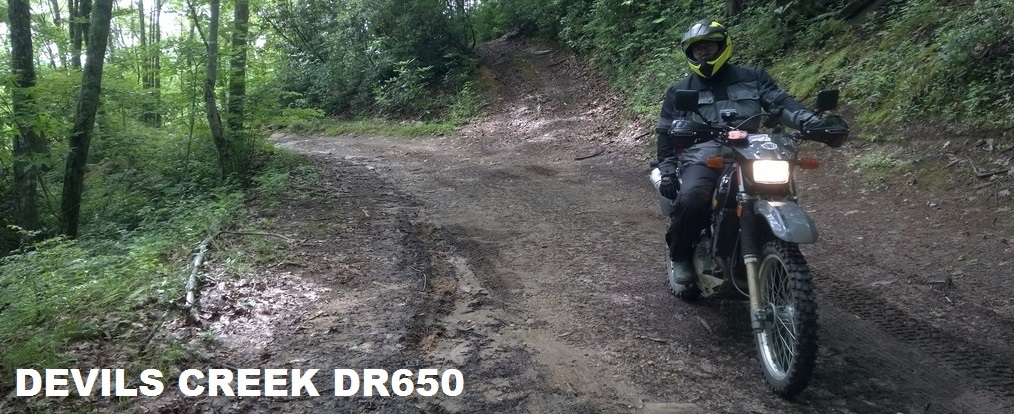Regearing a chain-driven motorcycle involves changing the Final Drive Ratio that, in turn, changes the engine's performance characteristics. Increasing the final drive ratio (i.e. gearing down) improves acceleration and low end torque. Decreasing the final drive ratio (i.e. gearing up) smooths top end performance generally increasing speed for highway applications.
Chain driven motorcycles have three drive ratios. They are the Primary Drive Ratio, the Gear Box Ratios (one for each of gears 1 thru 5) and the Final Drive Ratios. The Final Drive Ratio is the relationship between the countershaft (front) sprocket and the drive (rear wheel) sprocket.
Below is a summary of all ratios as provided in the DR650 Service Manual.
- Primary Drive Ratio: 61:28, 2.178
- Gear Box Ratio (1st Gear): 29:12, 2.416
- Gear Box Ratio (2nd Gear): 26:16, 1.625
- Gear Box Ratio (3rd Gear): 26:21, 1.238
- Gear Box Ratio (4th Gear): 21:21, 1.00
- Gear Box Ratio (5th Gear): 19:23, 0.826
- Final Drive Ratio: 42:15, 2.80
The Final Drive Ratio of the post-1995 Suzuki DR650 is 2.80 which is calculated simply as the number of teeth of the drive sprocket (42) divided by the number of teeth of the countershaft sprocket (15).
Top Speed with 42T Drive Sprocket (Source - Gearing Commander):
- 13T Countershaft = 84.8 mph
- 14T Countershaft = 91.4 mph
- 15T Countershaft = 97.9 mph
- 16T Countershaft = 104.4 mph
Back in April 2016, I put my DR650 (stock gearing) to the top-speed test and after multiple attempts the motorcycle topped out at 93 mph, measured using a GPS device. (Suzuki DR650 Top Speed)
I ran the 42:14 ratio on my 2012 model year DR650 for about the first 750 miles, which included the two-day, 500 mile 2021 Trans Florida Dual Sport and Adventure Rally. Overall, as you may expect, the better grunt in the low end of the powerband was better on the trails. However, those improvements did not outweigh the cost on the top end. As mentioned, increasing the ratio deceases speed and engine smoothness in the upper powerband. The speed wasn't the issue. The issue was the loss of smooth engine performance as the motorcycle began to hit highway speeds (around 65 mph). This is how final drive ratios are weighed and it's an individual, case-by-case situation. I went back to the 42:15.
Good news/bad news:
The good news is that changing out countershaft sprockets is all of cheap, easy, and quick. One could change in and out of sprockets that are suitable for different rides quite easily. The sprockets run around $15 for a good aftermarket branded sprocket, like JT, and it's all of 3 bolts to remove/replace. That doesn't include the fact that the rear axle and chain pullers also require adjustment.
The JTF.1448.15 Countershaft Sprocket was $15.25 on Amazon.
Ratios come down to simple math.
A desired ratio of 3.0, the result of a 42/14 sprocket configuration, can be accomplished a number of ways. If 3.0 is desired and one feels it necessary to retain the 15 tooth (or higher) countershaft sprocket, then the desired ratio is achieved my multiplying that ratio x the countershaft sprocket teeth: 3.0 x 15 = 45 tooth drive sprocket.
Similarly, a desired ratio of 3.2, the result of a 42/13 sprocket configuration, can be accomplished using the 15 tooth countershaft sprocket and a 48 tooth drive sprocket: 3.2 x 15 = 48 tooth drive sprocket.
You can do the math on other configurations. Or, JT Sprockets has a useful Gearing Ratio Cross Reference Chart available on their website that can be downloaded in .pdf and used as a reference.
Chain Length Considerations:
The stock chain on the post 1995 Suzuki DR650 is a DID525, 110 Links. Changes in sprockets may result in different chain lengths. For determining whether more (or less) links are required, consult the Gearing Commander Chain Links Calculator.




































